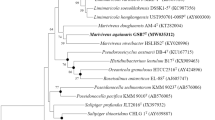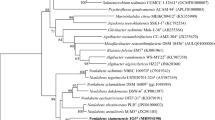Abstract
A novel bacterium, designated strain 13-2-B6T, was isolated from seawater adjacent to Songak Mountain on Jeju Island, South Korea. The novel strain was observed to be Gram-negative, aerobic, rod-shaped and motile with a single polar flagellum. On the basis of 16S rRNA gene sequence similarity, strain 13-2-B6T was determined to be phylogenetically closely related to the type strain of Antarctobacter heliothermus, currently the sole species of the genus Antarctobacter (family Rhodobacteraceae). Sequence similarity between the 16S rRNA genes of strain 13-2-B6T and A. heliothermus EL-219T is 96.9 %. Strain 13-2-B6T was found to grow optimally at 25–30 °C, pH 7.0–8.0 and 3 % (w/v) NaCl. The predominant isoprenoid quinone in strain 13-2-B6T was identified as ubiquinone Q-10 and the major fatty acids were identified as C18:1 ω7c and/or C18:1 ω6c. Phosphatidylglycerol, diphosphatidylglycerol, phosphatidylethanolamine, two unknown aminolipids, two unknown phospholipids, an unknown glycolipid and an unknown lipid were found to be components of the polar lipid profile. The G + C content of strain 13-2-B6T was determined to be 62 mol %. On the basis of its phenotypic, chemotaxonomic and phylogenetic distinctiveness, strain 13-2-B6T is considered to represent a novel species of the genus Antarctobacter, for which the name Antarctobacter jejuensis sp. nov. is proposed. The type strain is 13-2-B6T (=KCTC 42009T =JCM 19898T).

Similar content being viewed by others
References
Breznak JA, Costilow RN (1994) Physicochemical factors in growth. In: Gerhardt P, Murray RGE, Wood WA, Krieg NR (eds) Methods for General and Molecular Bacteriology. American Society for Microbiology, Washington, DC, pp 137–154
Felsenstein J (1985) Confidence limits on phylogenies: an approach using the bootstrap. Evolution 39:783–791
Felsenstein J (1993) PHYLIP (phylogeny inference package), version 3.5c. Department of Genetics, University of Washington, Seattle
Fitch WM (1971) Toward defining the course of evolution: minimum change for a specific tree topology. Syst Zool 20:406–416
Gonzalez JM, Mayer F, Moran MA, Hodson RE, Whitman WB (1997) Sagittula stellata gen. nov., sp. nov., a lignin-transforming bacterium from a coastal environment. Int J Syst Bacteriol 47:773–780
Hwang CY, Cho BC (2008) Ponticoccus litoralis gen. nov., sp. nov., a marine bacterium in the family Rhodobacteraceae. Int J Syst Evol Microbiol 58:1332–1338
Kim OS, Cho YJ, Lee K, Yoon SH, Kim M, Na H, Park SC, Jeon YS, Lee JH, Yi H, Won S, Chun J (2012) Introducing EzTaxon-e: a prokaryotic 16S rRNA gene sequence database with phylotypes that represent uncultured species. Int J Syst Evol Microbiol 62:716–721
Komagata K, Suzuki K (1987) Lipid and cell-wall analysis in bacterial systematics. Methods Microbiol 19:161–207
Labrenz M, Collins MD, Lawson PA, Tindall BJ, Braker G, Hirsch P (1998) Antarctobacter heliothermus gen. nov., sp. nov., a budding bacterium from hypersaline and heliothermal Ekho Lake. Int J Syst Bacteriol 48:1363–1372
Mesbah M, Premachandran U, Whitman WB (1989) Precise measurement of the G + C content of deoxyribonucleic acid by high performance liquid chromatography. Int J Syst Bacteriol 39:159–167
Minnikin DE, O’Donnell AG, Goodfellow M, Alderson G, Athalye M, Schaal A, Patel PV, Alshamaony L (1977) Polar lipid composition in the classification of Nocardia and related bacteria. Int J Syst Bacteriol 27:104–117
Minnikin DE, O’Donnell AG, Goodfellow M, Alderson G, Athalye M, Schaal A, Parlett JH (1984) An integrated procedure for the extraction of bacterial isoprenoid quinones and polar lipids. J Microbiol Methods 2:233–241
Saitou N, Nei M (1987) The neighbor-joining method: a new method for reconstructing phylogenetic trees. Mol Biol Evol 4:406–425
Sambrook J, Russell DW (2001) Molecular cloning: a laboratory manual. Cold Spring Harbor Laboratory, New York
Sasser M (2001) Identification of bacteria by gas chromatography of cellular fatty acids, Technical Note 101. MIDI Inc, Newark
Smibert RM, Krieg NR (1994) Phenotypic characterization. In: Gerhardt P, Murray RGE, Wood WA, Krieg NR (eds) Methods for General and Molecular Bacteriology. American Society for Microbiology, Washington, DC, pp 607–654
Tamaoka J, Komagata K (1984) Determination of DNA base composition by reversed-phase high-performance liquid chromatography. FEMS Microbiol Lett 25:125–128
Tamura K, Stecher G, Peterson D, Filipski A, Kumar S (2013) MEGA6: Molecular evolutionary genetics analysis version 6.0. Mol Biol Evol 30:2725–2729
Thompson JD, Gibson TJ, Plewniak F, Jeanmougin F, Higgins DG (1997) The CLUSTAL_X windows interface: flexible strategies for multiple sequence alignment aided by quality analysis tools. Nucleic Acids Res 25:4876–4882
Tittsler RP, Sandholzer LA (1936) The use of semi-solid agar for the detection of bacterial motility. J Bacteriol 31:575–580
Weisburg WG, Barns SM, Pelletier DA, Lane DJ (1991) 16S ribosomal DNA amplification for phylogenetic study. J Bacteriol 173:697–703
Acknowledgments
We are grateful to Dr. J.P. Euzéby for his advice on naming this microorganism. This work was supported by a grant from the National Fisheries Research and Development Institute (RP-2014-FR-014), and a grant from the KRIBB Research Initiative Program (KGM 4111443).
Author information
Authors and Affiliations
Corresponding author
Additional information
Hyangmi Kim and Jae-Bong Lee were contributed equally to this study.
Electronic supplementary material
Below is the link to the electronic supplementary material.
Rights and permissions
About this article
Cite this article
Kim, H., Lee, JB., Oh, HW. et al. Antarctobacter jejuensis sp. nov., isolated from seawater in Jeju, Korea. Antonie van Leeuwenhoek 106, 1081–1087 (2014). https://doi.org/10.1007/s10482-014-0276-3
Received:
Accepted:
Published:
Issue Date:
DOI: https://doi.org/10.1007/s10482-014-0276-3




